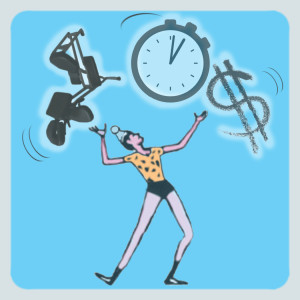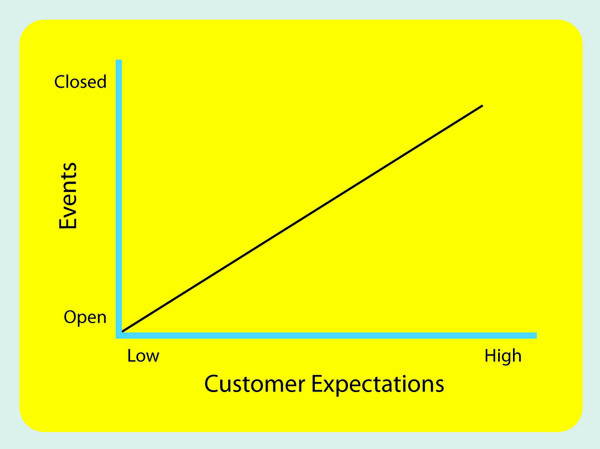 This question recently came in from a long-time chair massage practitioner:
This question recently came in from a long-time chair massage practitioner:
Is there is a calculation for figuring out in advance how many people in a group (office, convention, health fair, etc.) will get a chair massage at a one-time event if it is offered for free? Say the employer or somebody else is paying for the service.
While I know of no formula or rule of thumb for that particular calculation, let’s reframe the question in terms of expectations. Whoever is paying for the massages wants to purchase just enough service so that the people expecting to receive a massage are not disappointed without paying for more massage time than needed.
So, what we are really looking for is both the number of people at the event expecting to get a chair massage and how high or low is their level of expectation. One way to gauge the level of expectation would be by classifying whether the event is open, closed or somewhere in between.
An open event is where there is a virtually unlimited number of people that could possibly get a massage, such as at a convention or street fair where chair massage is used as a traffic builder to get people to stop at a booth. In those situations, the expectation of getting chair massage will be relatively low.
A closed event has a fixed number of potential massage recipients, such as a one-time event in an office that might be used as a reward or incentive for the employees. In that case, the expectation of getting a massage would tend to be high.
 In between open and closed events are other situations, such as health fairs, where people might know that there will be free chair massage, might want one, but understand that there are a limited number of massage slots available, so their disappointment will be tolerable.
In between open and closed events are other situations, such as health fairs, where people might know that there will be free chair massage, might want one, but understand that there are a limited number of massage slots available, so their disappointment will be tolerable.
Open events
The open event is the easiest one to schedule because it is based on the budget of the customer paying for the services. Once the budget is determined, say $700, that number is divided by your hourly rate, say $70 per hour, which gives you the number of practitioner hours they will be paying for, in this example 10 hours. If the event runs for 5 hours, you would make two practitioners available.
The next question is how long are the massage slots that the customer wants for the event: 5-minute, 10-minute, 15-minute, or longer. Dividing the number of practitioner hours by the length of each massage gives you the approximate number of massage slots. It is approximate because you will probably have to use some of those slots for practitioner breaks, if the length of the event is greater than 2.5 to 3 hours. I personally don’t like to do more than 3 hours of massage without a break.
To finish the calculation for this example, say the customer wants 10-minute massage slots. That would be 6 slots an hour times 10 hours for a total of 60 slots. Subtract two 20-minute breaks (4 slots, one for each practitioner) and you could guarantee the customer that you will deliver 54 massages.
While the event organizer may have advertised the availability of free chair massage in advance of the event and some people may be disappointed if they didn’t get a massage, they generally won’t hold it against the sponsor of the event.
Closed events
In a closed event there is typically a fixed number of people to be massaged. For example, a company wants to thank each of its 100 employees with a chair massage for meeting a deadline. Here the calculations get a bit more complicated but, as a starting point, it is useful again to understand the calculation described above.
If each employee gets a massage in a 15-minute slot (4 slots per hour), then 25 practitioner hours will be required at a maximum cost of $1750 (if you are charging $70/hour). Since it is unlikely that all 100 employees will be able to get a massage (some will be sick, on vacation or just won’t want a massage), the next step is to make an estimate with the customer for the number of slots to schedule.
After you explain the calculation above, if there is a long lead time to the event, some customers will want to survey their employee’s interest to come up with a number, others will want to just make their best guess.
In any case, the number of practitioner hours you decide upon is what goes into the contract with the customer and that is how the schedule gets set. If the customer opts for a conservative number of slots and you have the flexibility, you could offer to add more slots if the original amount fills up quickly and they end up having a waiting list. That would have to be spelled out in the contract and agreed upon by the practitioners actually doing the massage.
In closed events there is often an implied guarantee that everyone who wants a massage will get a massage, so ensuring that both the customer and the recipients are happy is challenging. Thus, when you are working off a schedule, make sure that you have the extension number of each person scheduled in case you have to call to remind them of their appointment. If, on the day of the event, someone is sick, you can also offer to do double sessions if the event coordinator cannot otherwise fill in the slot.
Semi-closed events
A corporate health fair is a typical semi-closed event where generally a fixed number of people are expected but there is no guarantee of everyone getting a massage.
As in the first two cases, after you explain the basic calculation, you can help the customer to decide how many slots and what slot length they can purchase with their budget constraints.
A final word about scheduling
Customers like to get what they paid for, which means they generally don’t like to see practitioners standing around doing nothing. This can be tricky in situations where there is no pre-scheduling of the massage slots and recipients get taken on a first-come, first-served basis (often involving a clipboard).
In those situations, having some flexibility in the length of the massage is helpful. For example, often things are slow at the beginning of the event. That is a good time to give longer chair massages. As the number of people in line waiting for a massage grows, the practitioners can begin shortening their massages until the minimum slot-time agreed upon is reached. The goal should be to always have someone in every chair getting a massage, even if it is the practitioners working on each other.
Meeting expectations
Understanding the expectations of the customer and the massage recipients is key to repeat business and positive recommendations. Remember, customers come to you because you are the expert. Helping to clarify the decisions they have to make is step one. Now delivering a great massage is up to you.
A special shout out to Tom Darilek and Debra Rilea for their help in framing this question and response.




David:
Shame we didn’t have time to discuss this piece:
Calculating Services for Pre-Paid Events
as we’ve had a lot of experience with this over the years…..as recently as last week, where I contracted with 3 other practitioners and Candice and I provided chair massage service at a charity golf outing for a Cerebral Palsy Foundation fundraiser at the Trump National Golf Club in Briarcliff, NY…..I recommended to the event manager that we provide 4 practitioners at the break hole, which usually is between the 9th green and 10th tee, and where all four members of each foursome can get a 5-7 minute neck and shoulder chair massage, along with their hot dog and beer, and one practitioner at the pool for the non-golfers….I also suggested that we be stationed to start at the noon shotgun start through the 5:00pm end of the golf activity.
As it turned out, and not discovered until the day of the event, the “break hole” was at the Clubhouse, where a buffet luncheon, bar, and other activities were available to entertain the players, resulting in several periods of practitioner inactivity…..
As the practitioner at the pool was non-stop for the 3 hours on-duty, my post-event recommendation for scheduling at next year’s event be 2 practitioners, instead of 4, from 10:00am (start of registration)-5:00pm for the golfers, and 1 at the pool from 12:00-4:00…..
Another comment regarding the closed event situation you mentioned was that, in my experience, there will be 5-10% of any group that will not accept an invitation for a free massage, due, in part, to some previous experience with touch that has soured them to receiving it, even if its free. That has helped me in estimating the number of recipients to be planned for….
Hope that helps,
Best,
Russ
What about time between client sessions? When one session ends another doesn’t just start right up-time must be given to clean and prepare the chair for the next massage. Also introductions and instructions must be allowed for as well as the next in line might not be ready to jump on the chair. I’m thinking at least 3- 5 minutes must be allowed, which will mean not 6 – 10 minute sessions/hour/practitioner but probably more like 4-4.6 sessions/hour/practitioner and thats without a break. So instead of the 54 promised I would say somewhere between 40 and 46 (less if you want that break). Am I right or not?